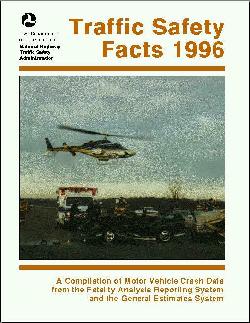


FARS Query System now available
Fatality information is derived from the Fatality Analysis Reporting System (FARS). FARS includes motor vehicle traffic crashes that result in fatality to a vehicle occupant or nonmotorist, from injuries resulting from a traffic crash, that occur within 30 days of the crash. The final FARS file is normally completed around Memorial Day, at which time the final quality control procedures are implemented. When these procedures are completed, NCSA can begin to create our fact sheets and release the new data. When the 1999 data are available, it will be announced on this page.
 FARS contains data on all fatal traffic crashes within the 50 states, the District
of Columbia, and Puerto Rico. The data system was conceived, designed, and developed
by the National Center for Statistics and Analysis (NCSA) to assist the traffic
safety community in identifying traffic safety problems, developing and implementing
vehicle and driver countermeasures, and evaluating motor vehicle safety standards
and highway safety initiatives.
FARS contains data on all fatal traffic crashes within the 50 states, the District
of Columbia, and Puerto Rico. The data system was conceived, designed, and developed
by the National Center for Statistics and Analysis (NCSA) to assist the traffic
safety community in identifying traffic safety problems, developing and implementing
vehicle and driver countermeasures, and evaluating motor vehicle safety standards
and highway safety initiatives.
NCSA responds to over 3,000 requests for information and sends out more than
50 computer tapes of FARS data each year. FARS data are used extensively
within NHTSA, and requests are received from sources such as state and local
governments, research organizations, private citizens, the auto and insurance
industries, Congress, and the media.
FARS data can be used to answer many questions on the safety of vehicles, drivers, traffic situations, and roadways. FARS data can also be accessed at the state level by the FARS analyst to respond to state safety issues. To protect individual privacy, no personal information, such as names, addresses, or specific crash locations, is coded.
Data are available for every year since FARS was established in 1975. Users can obtain FARS data in several ways:
NHTSA has a contract with an agency in each state to provide information
on fatal crashes. FARS analysts are state employees who extract the information
and put it in a standard format. Each FARS analyst attends a formal training
program, and also receives on-the-job training.
Data on fatal motor vehicle traffic crashes are gathered from the state's
own source documents, and are coded on standard FARS forms. The analysts
obtain the documents needed to complete the FARS forms, which generally include
some or all of the following:
To be included in FARS, a crash must involve a motor vehicle travelling
on a traffic way customarily open to the public, and result in the death
of a person (either an occupant of a vehicle or a non-motorist) within 30
days of the crash. The FARS file contains descriptions of each fatal crash
reported. Each case has more than 100 coded data elements that characterize
the crash, the vehicles, and the people involved. The specific data elements
may be modified slightly at times, in response to users' needs and highway
safety emphasis areas. All data elements are reported on four forms:
The Accident Form asks for information such as the time and location
of the crash, the first harmful event, whether it is a hit-and-run crash,
whether a school bus was involved, and the number of vehicles and people
involved.
The Vehicle and Driver Forms call for data on each crash-involved vehicle and driver. Data include the vehicle type, initial and principle impact points, most harmful event, and drivers' license status.
The Person Form contains data on each person involved in the crash, including age, gender, role in the crash (driver, passenger, non-motorist ), injury severity, and restraint use.
In addition, there are FARS Alcohol files which contain driver and nonoccupant BAC estimates, as well as overall crash alcohol estimates, which are used to supplement the data files when no alcohol information would otherwise be available. Information on these files are available in two reports, A Method for Estimating Posterior BAC Distributions for Persons Involved in Fatal Traffic Accidents (DOT HS 807 094) and A Guide to Using the Fatal Accident Reporting System BAC Distribution Files (DOT HS 807 095) available from NTIS.
Quality Control is a vital system feature. One important part of the quality
control program is a series of consistency checks, which ensure that no
inconsistent data are entered. For example, if an analyst codes 11:00 am
as the time of the crash and "dusk" as the light condition, these codes would
be rejected as inconsistent. Other checks are for timeliness, completeness,
and accuracy. Statistical control charts are also employed to monitor the
coding of key data elements over time.
 Please
send any comments to:
ncsaweb@nhtsa.dot.gov
Please
send any comments to:
ncsaweb@nhtsa.dot.gov
If you are requesting data or other information, your including a fax number, phone number, or postal address will enable us to respond more quickly and thoroughly to your request. You can also phone in information requests to our automated answering system at 1-800-934-8517, or (202) 366-4198 locally in the Washington, DC area.
Return to NCSA Main Page
Return to NCSA Welcome Page